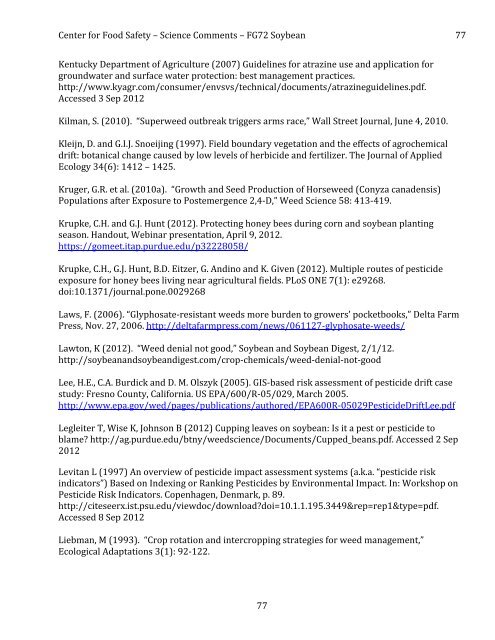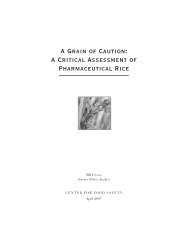a four-fold rise - Center for Food Safety
a four-fold rise - Center for Food Safety
a four-fold rise - Center for Food Safety
Create successful ePaper yourself
Turn your PDF publications into a flip-book with our unique Google optimized e-Paper software.
<strong>Center</strong> <strong>for</strong> <strong>Food</strong> <strong>Safety</strong> – Science Comments – FG72 Soybean <br />
77 <br />
Kentucky Department of Agriculture (2007) Guidelines <strong>for</strong> atrazine use and application <strong>for</strong> <br />
groundwater and surface water protection: best management practices. <br />
http://www.kyagr.com/consumer/envsvs/technical/documents/atrazineguidelines.pdf. <br />
Accessed 3 Sep 2012 <br />
Kilman, S. (2010). “Superweed outbreak triggers arms race,” Wall Street Journal, June 4, 2010. <br />
Kleijn, D. and G.I.J. Snoeijing (1997). Field boundary vegetation and the effects of agrochemical <br />
drift: botanical change caused by low levels of herbicide and fertilizer. The Journal of Applied <br />
Ecology 34(6): 1412 – 1425. <br />
Kruger, G.R. et al. (2010a). “Growth and Seed Production of Horseweed (Conyza canadensis) <br />
Populations after Exposure to Postemergence 2,4-‐D,” Weed Science 58: 413-‐419. <br />
Krupke, C.H. and G.J. Hunt (2012). Protecting honey bees during corn and soybean planting <br />
season. Handout, Webinar presentation, April 9, 2012. <br />
https://gomeet.itap.purdue.edu/p32228058/ <br />
Krupke, C.H., G.J. Hunt, B.D. Eitzer, G. Andino and K. Given (2012). Multiple routes of pesticide <br />
exposure <strong>for</strong> honey bees living near agricultural fields. PLoS ONE 7(1): e29268. <br />
doi:10.1371/journal.pone.0029268 <br />
Laws, F. (2006). “Glyphosate-‐resistant weeds more burden to growers’ pocketbooks,” Delta Farm <br />
Press, Nov. 27, 2006. http://deltafarmpress.com/news/061127-‐glyphosate-‐weeds/ <br />
Lawton, K (2012). “Weed denial not good,” Soybean and Soybean Digest, 2/1/12. <br />
http://soybeanandsoybeandigest.com/crop-‐chemicals/weed-‐denial-‐not-‐good <br />
Lee, H.E., C.A. Burdick and D. M. Olszyk (2005). GIS-‐based risk assessment of pesticide drift case <br />
study: Fresno County, Cali<strong>for</strong>nia. US EPA/600/R-‐05/029, March 2005. <br />
http://www.epa.gov/wed/pages/publications/authored/EPA600R-‐05029PesticideDriftLee.pdf <br />
Legleiter T, Wise K, Johnson B (2012) Cupping leaves on soybean: Is it a pest or pesticide to <br />
blame? http://ag.purdue.edu/btny/weedscience/Documents/Cupped_beans.pdf. Accessed 2 Sep <br />
2012 <br />
Levitan L (1997) An overview of pesticide impact assessment systems (a.k.a. “pesticide risk <br />
indicators”) Based on Indexing or Ranking Pesticides by Environmental Impact. In: Workshop on <br />
Pesticide Risk Indicators. Copenhagen, Denmark, p. 89. <br />
http://citeseerx.ist.psu.edu/viewdoc/download?doi=10.1.1.195.3449&rep=rep1&type=pdf. <br />
Accessed 8 Sep 2012 <br />
Liebman, M (1993). “Crop rotation and intercropping strategies <strong>for</strong> weed management,” <br />
Ecological Adaptations 3(1): 92-‐122. <br />
77







